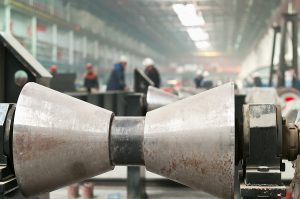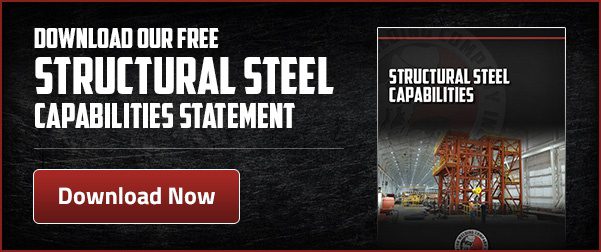The Role of Rolling and Forming in Custom Industrial Fabrication
In custom metal fabrication, precision isn’t just a benefit—it’s a requirement. The components built for industrial environments often face enormous stresses, extreme temperatures, and long-term wear. For these parts to function correctly, they must start with solid fundamentals. That’s where rolling and forming come into play.
These two processes are cornerstones of heavy-duty metalwork, particularly when working with thick plate and large-scale components. Whether it’s creating cylindrical ductwork, conical transitions, or structural enclosures, rolling and forming make it possible to shape metal into strong, reliable configurations that perform in the real world.
At Swanton Welding Company, these services are more than just capabilities—they’re part of a larger commitment to quality fabrication that supports industries nationwide.
What Is Rolling and Forming?
Rolling and forming are metal shaping processes used to transform flat metal stock into curved or angled geometries. The goal is to bend and shape metal without cutting or welding it, preserving its structural integrity while achieving specific dimensions and contours.
Rolling involves passing metal through a series of rollers that gradually shape it into cylindrical, conical, or rounded forms. This is a go-to method for forming large steel or aluminum plates into shells for tanks, chimneys, ductwork, or pipe systems.
Forming refers more broadly to the process of bending, pressing, or shaping metal using mechanical force. This can include everything from brake forming and press bending to more complex roll forming sequences where metal is gradually shaped along a continuous path.
Together, these processes are utilized in numerous industries, including HVAC and energy, agriculture, marine, and heavy equipment manufacturing.

The Importance of Rolling in Industrial Fabrication
Rolling plays a key role in fabricating curved components that require both strength and precise geometry. This is especially true for applications involving pressure vessels, storage tanks, flue systems, and industrial ductwork.
Some of the most common components produced through rolling include:
- Cylinders: These can be used as structural elements, pressure chambers, or flow channels for gases, liquids, and particulates.
- Cones: Conical shapes are often used as transitions between different duct sizes, or as hoppers, chutes, and funnels.
- Shell segments: For larger assemblies like silos, stacks, and tanks, shells are rolled and then welded into a final structure.
- Transitions: Rolling allows the creation of smooth, tapered, or curved transitions between components of different shapes and sizes.
By using precision rolling machines capable of handling thick, heavy plate, Swanton Welding can produce consistent, uniform curves in even the toughest materials. This level of control is essential for maintaining structural performance and accurate fit-up during final assembly.
How Forming Complements Rolling
While rolling is ideal for continuous curves, many industrial components also require angled bends, flanges, or structural reinforcements. That’s where forming becomes essential.
Forming techniques enable metal fabricators to create intricate features that enhance installation, durability, and functionality. For instance:
- Brake forming can be used to bend enclosures, control panels, and structural housings with sharp corners or consistent angles.
- Press forming enables the shaping of a thick plate into multi-angled or offset configurations, often used in equipment frames or base plates.
- Roll forming, a continuous process, is used to create long lengths of channel, angle, or custom profiles from coil stock.
The ability to combine these forming techniques with plate rolling gives fabricators the flexibility to create components that meet both structural and functional demands—whether it’s a precision transition duct or a multi-sided enclosure for an outdoor electrical system.
Real-World Applications
Custom industrial fabrication is rarely about making a single part. It’s about building systems, like ductwork, processing units, containment structures, or mechanical housings, that must integrate seamlessly with everything around them.
Rolling and forming play a foundational role in many of these systems, especially in the following areas:
- Industrial Duct Systems
Large-scale HVAC and exhaust systems rely on rolled and formed components to guide airflow, manage pressure changes, and connect various sections of piping or equipment. Cylindrical ducts, cone reducers, and curved elbows are all fabricated through precision rolling.
These components need to meet exact specifications to maintain airflow efficiency and ensure safe operation under high-pressure or high-temperature conditions.
- Protective Enclosures and Structural Housings
Industrial environments often require customized housings to shield electronics, compressors, or sensitive controls from dust, debris, weather, and mechanical damage. Rolling and forming allow fabricators to shape thick-gauge steel or aluminum into rugged, reliable housings tailored to the size and layout of the equipment they’re protecting.
- Tanks, Silos, and Pressure Vessels
Creating these structures starts with rolled shells that are then joined together through high-strength welding. Whether they hold water, chemicals, grains, or gases, these vessels need to maintain structural integrity under load, making the accuracy of the rolling process a top priority.
- Heavy Equipment and Machinery Bases
Equipment bases often require a mix of rolled and formed parts to support motors, bearings, or rotating machinery. Formed flanges and stiffeners provide strength, while rolled sections help distribute weight and resist deformation.
Precision and Repeatability
One of the key benefits of working with a shop that specializes in rolling and forming is the repeatability it offers. When fabricators combine skilled technicians with CNC-controlled machines, it becomes possible to replicate parts with minimal variation—an essential factor when building large systems with multiple connection points.
At Swanton Welding, this precision isn’t limited to the machines. It’s built into the process from the start. Using CAD modeling and material traceability, their team plans each job to account for material springback, edge alignment, and thickness variation. The result? Parts that not only fit but last.
Material Considerations
Different projects require different materials, and rolling and forming must consider the specific properties of each. Swanton Welding works with a wide variety of metals, including:
- Carbon steel for durability and load-bearing strength
- Stainless steel for corrosion resistance in food, chemical, and marine applications
- Aluminum for lightweight performance in transportation and enclosure systems
Each metal behaves differently under pressure and heat, which is why it’s important to have experienced fabricators involved in the planning and execution of each job.
Built for Industrial Demands
Rolling and forming aren’t about making parts look good in the shop. They’re about creating components that perform in harsh, demanding environments, where failure isn’t an option.
Swanton Welding understands what’s at stake. That’s why their rolling and forming operations are built for heavy-duty work: thick plate, large dimensions, tight tolerances, and rugged materials. Whether you need a cone reducer for a 48” duct line or a custom-formed base for a power generator, they have the equipment and experience to deliver.
Why Choose Swanton Welding?
Swanton Welding Company has spent decades building its reputation as a trusted provider of large-scale custom fabrication. Their rolling and forming services are at the core of that offering, providing customers with the ability to shape and strengthen metal for nearly any industrial purpose.
What sets them apart is their commitment to:
- Precision: CNC-controlled rolling machines and experienced technicians
- Scale: Capacity to handle heavy-gauge material and large formats
- Support: Full-service fabrication from design to welding and finishing
- Customization: Every component is built to spec, not mass-produced
Whether you’re building a full duct system or just need a few rolled cones to complete an upgrade, Swanton can support your project with quality workmanship and reliable turnaround.
From Concept to Completion with Swanton Welding
Rolling and forming are the fundamental building blocks of many components used in industrial fabrication. They make it possible to shape tough materials into cylinders, cones, transitions, and enclosures that perform in demanding environments. These processes may not always be visible once an installation is complete, but they are essential to how that system works, day in and day out.
Swanton Welding Company is proud to support manufacturers, contractors, and engineers with experienced rolling and forming services. If you’re planning a project that requires precision-formed components built to withstand industrial conditions, contact Swanton today to see how they can help bring your design to life.

